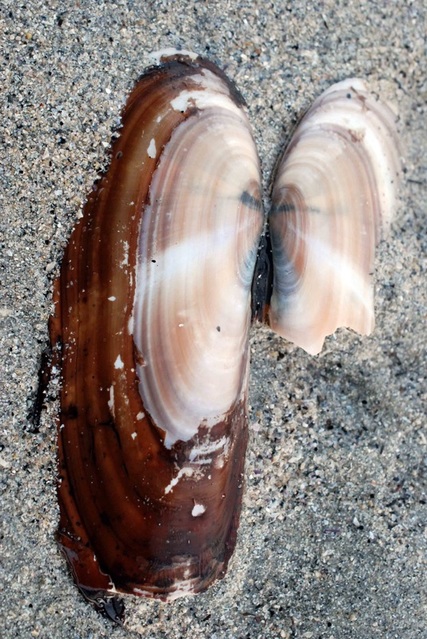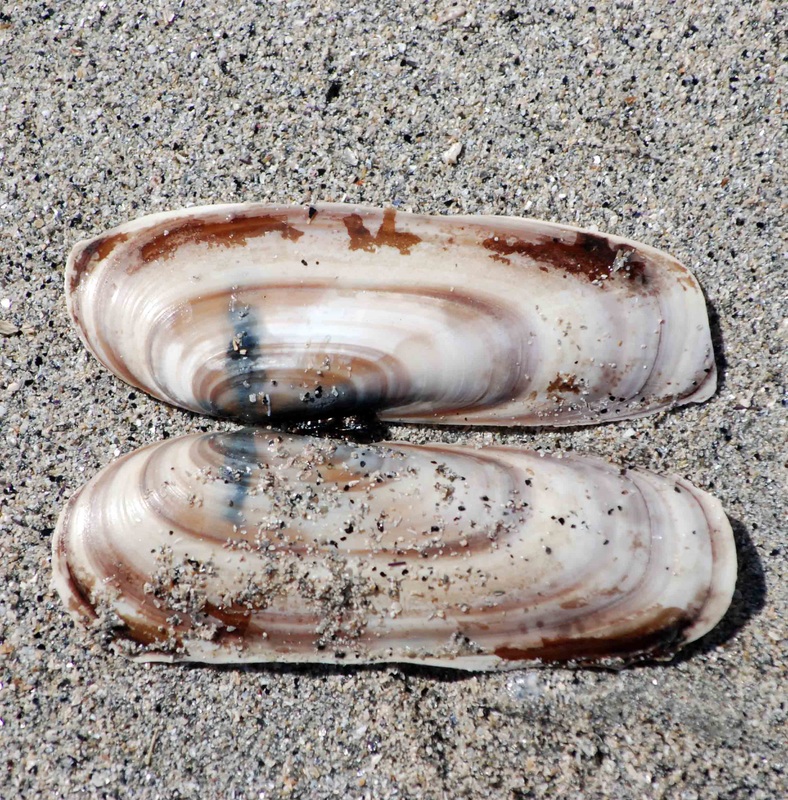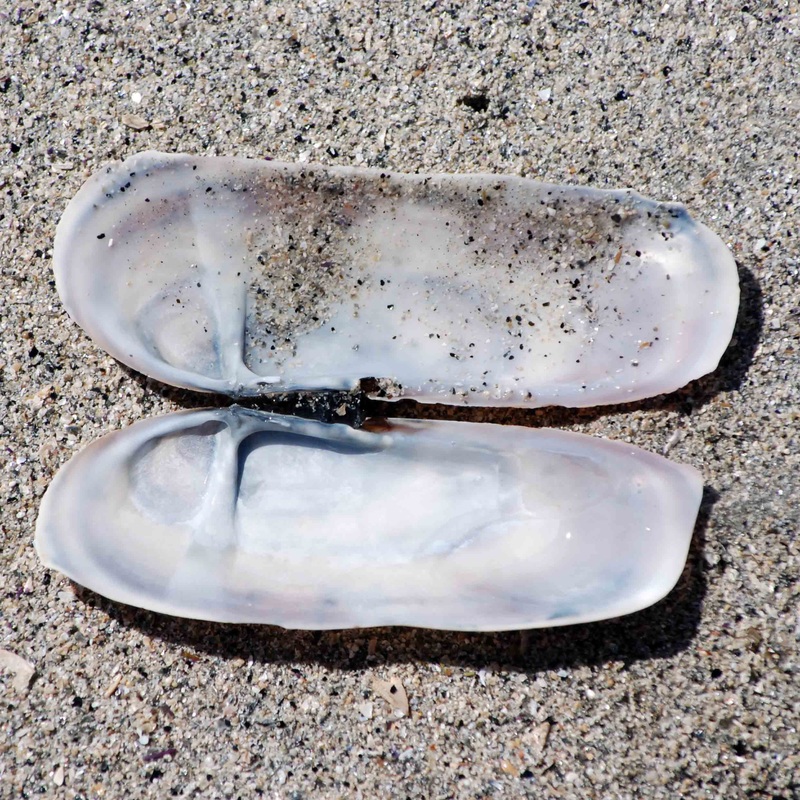Pacific razor-clam, northern razor-clam • Siliqua patula • Heiltsuk/Haíɫzaqv - C̓íkva
{Siliqua = pod; patula = open}
Identification
The Pacific razor-clam shell has a long and narrow shape, is covered in a shiny olive to brown periostracum, and has a white interior tinged with pink or purple. The hinge is offset to the anterior end and a slightly angled rib (slanting towards the anterior end) extends from the hinge across the interior of each shell valve. The shell is thin, brittle, and breaks easily. When occupied the shell gapes at all sides. The clam has short white siphons that are fused together except at the tips. This is a large species, with shells reaching 19 cm long.
Habitat & Range
This species burrows into sand on exposed beaches; it usually inhabits the intertidal, though may be found up to 55 m deep. Its range extends from Cook Inlet in the Gulf of Alaska to Morrow Bay in central California.
Human Uses
The meat from this clam is considered gourmet, and is a target for First Nation, commercial, and recreational harvests. Pay close attention to biotoxin warnings when harvesting clams and other bivalves for eating. This species is also used for crab bait.
Intriguing Info
This clam can be hard to catch as it able to dig very quickly. Its gaping shell edges can be sharp, meaning it may live up to its name and cut into skin when grasped incorrectly. It orients its hinge to the ocean when buried, however, so if care is taken to grasp the clam from that side no cuts should occur.
iNaturalist
https://www.inaturalist.org/taxa/117615-Siliqua-patula
The Pacific razor-clam shell has a long and narrow shape, is covered in a shiny olive to brown periostracum, and has a white interior tinged with pink or purple. The hinge is offset to the anterior end and a slightly angled rib (slanting towards the anterior end) extends from the hinge across the interior of each shell valve. The shell is thin, brittle, and breaks easily. When occupied the shell gapes at all sides. The clam has short white siphons that are fused together except at the tips. This is a large species, with shells reaching 19 cm long.
Habitat & Range
This species burrows into sand on exposed beaches; it usually inhabits the intertidal, though may be found up to 55 m deep. Its range extends from Cook Inlet in the Gulf of Alaska to Morrow Bay in central California.
Human Uses
The meat from this clam is considered gourmet, and is a target for First Nation, commercial, and recreational harvests. Pay close attention to biotoxin warnings when harvesting clams and other bivalves for eating. This species is also used for crab bait.
Intriguing Info
This clam can be hard to catch as it able to dig very quickly. Its gaping shell edges can be sharp, meaning it may live up to its name and cut into skin when grasped incorrectly. It orients its hinge to the ocean when buried, however, so if care is taken to grasp the clam from that side no cuts should occur.
iNaturalist
https://www.inaturalist.org/taxa/117615-Siliqua-patula
References
Cowles, D. (2005). Siliqua patula (Dixon, 1788). Invertebrates of the Salish Sea. Rosario Beah Marine Laboratory. Accessed 08/09/2015.
Harbo, R. (1997). Shells & Shellfish of the Pacific Northwest. Madeira Park, BC: Harbour Publishing. Pp. 34, 63, 155.
Lamb, A., and Hanby, B. (2005). Marine Life of the Pacific Northwest [electronic version]. Madeira Park, BC: Harbour Publishing.
Nelson, D. (1994). Razor Clam. Alaska Department of Fish & Game. Accessed 98/09/2015.
Authors and editors of page
Kelly Fretwell and Brian Starzomski (2015).
Cowles, D. (2005). Siliqua patula (Dixon, 1788). Invertebrates of the Salish Sea. Rosario Beah Marine Laboratory. Accessed 08/09/2015.
Harbo, R. (1997). Shells & Shellfish of the Pacific Northwest. Madeira Park, BC: Harbour Publishing. Pp. 34, 63, 155.
Lamb, A., and Hanby, B. (2005). Marine Life of the Pacific Northwest [electronic version]. Madeira Park, BC: Harbour Publishing.
Nelson, D. (1994). Razor Clam. Alaska Department of Fish & Game. Accessed 98/09/2015.
Authors and editors of page
Kelly Fretwell and Brian Starzomski (2015).







